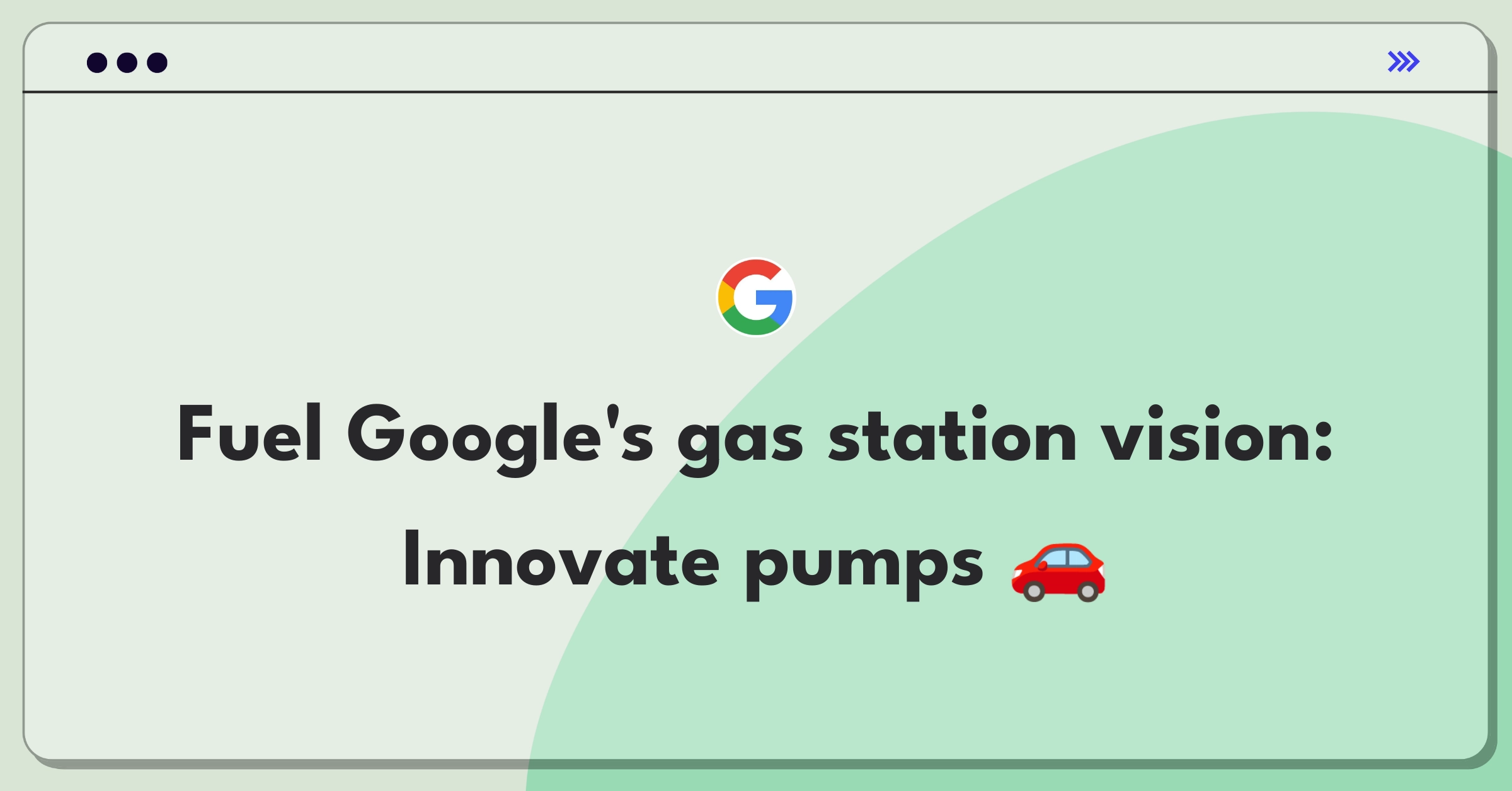Thank you for providing such a comprehensive framework for addressing this product strategy question. I'll structure my response according to the guidelines you've outlined, focusing on Google's potential entry into the gas station business. Let me begin by restating the problem and setting the agenda for my response.
Introduction
The strategic problem at hand is to determine the product or service Google should build if entering the gas station business, and to define the Minimum Viable Product (MVP) for this initiative. This challenge involves leveraging Google's technological expertise and data-driven approach to disrupt and innovate within a traditional industry.
Key business objectives for this strategy would likely include:
- Expanding Google's ecosystem into physical spaces
- Leveraging data and technology to improve customer experience
- Creating new revenue streams and business models
- Establishing a foothold in the energy and transportation sectors
I'll address this challenge by following these strategic steps:
- Clarify strategic goals
- Conduct market and competitive analysis
- Define product vision and roadmap
- Prioritize strategic initiatives
- Develop an execution plan and resource allocation strategy
- Establish metrics and KPIs
- Implement risk management and contingency planning
Let's begin by clarifying the strategic goals for this initiative.
Step 1
Clarify the Strategic Goals (3-4 minutes)
To ensure our strategy aligns with Google's overall objectives, we need to clarify several key areas:
Let me provide hypothetical answers to these questions based on my understanding of Google's typical approach:
Primary Objective: Google's main goal would likely be to create a data-driven, technology-enhanced gas station experience that integrates with its existing ecosystem of services. This aligns with Google's mission to organize the world's information and make it universally accessible and useful.
Why this matters: Understanding the primary objective will guide our entire strategy, ensuring that we're not just building a traditional gas station but creating a Google-worthy experience.
Hypothetical answer: The primary objective is to create a network of smart, connected gas stations that leverage Google's strengths in data analytics, machine learning, and user experience design.
Impact on strategic approach: This objective will push us to focus on digital integration, data collection, and creating a unique user experience rather than competing solely on fuel prices or convenience store offerings.
Product Lifecycle Stage: As a new entrant in this market, we're at the introduction stage. However, Google has experience launching physical products (e.g., Google Pixel phones) and services (e.g., Google Fiber).
Why this matters: The introduction stage requires a focus on education, adoption, and rapid iteration based on user feedback.
Hypothetical answer: We're at the introduction stage, but we can leverage Google's experience in launching new products and services to accelerate our learning curve.
Impact on strategic approach: We'll need to emphasize user education, potentially start with a limited geographic rollout, and plan for rapid iterations based on real-world usage data.
Customer Segments: Given Google's consumer-focused approach, the primary target would likely be individual drivers, with a secondary focus on fleet operators.
Why this matters: Different customer segments have distinct needs and behaviors, which will influence our product design and marketing strategy.
Hypothetical answer: Our primary focus will be on individual consumers who are tech-savvy and already engaged with Google's ecosystem.
Impact on strategic approach: We'll design the initial product with features that appeal to early adopters and integrate seamlessly with other Google services like Maps, Pay, and Assistant.
Market Context: The energy and transportation sectors are undergoing significant changes, with a shift towards electric vehicles, increased focus on sustainability, and growing demand for personalized, convenient experiences.
Why this matters: These trends will shape customer expectations and potential regulatory requirements.
Hypothetical answer: We're entering a market that's ripe for disruption, with increasing demand for smart, sustainable, and connected transportation solutions.
Impact on strategic approach: Our product should be future-proof, potentially incorporating support for both traditional and alternative fuels, and emphasizing sustainability and efficiency.
Resource Constraints: While Google has significant financial resources, the main constraints might be in physical infrastructure development and navigating the regulatory landscape of the fuel industry.
Why this matters: These constraints will impact our rollout strategy and potential partnerships.
Hypothetical answer: Our main constraints will be in rapidly developing physical infrastructure and ensuring compliance with varied local and national regulations.
Impact on strategic approach: We should consider partnerships with existing gas station operators or real estate developers to accelerate our physical presence, while leveraging Google's legal and policy teams to navigate regulatory challenges.
Based on these assumptions, I'll proceed with my analysis focusing on creating a network of smart, connected gas stations that integrate with Google's existing ecosystem, targeting tech-savvy individual consumers initially, with an eye towards future sustainability trends.
Tip
I'll take a moment to organize my thoughts and ensure my strategic approach aligns with Google's objectives of creating innovative, data-driven solutions that enhance user experiences across various aspects of daily life.
Subscribe to access the full answer
Monthly Plan
The perfect plan for PMs who are in the final leg of their interview preparation
$99 /month
- Access to 8,000+ PM Questions
- 10 AI resume reviews credits
- Access to company guides
- Basic email support
- Access to community Q&A
Yearly Plan
The ultimate plan for aspiring PMs, SPMs and those preparing for big-tech
$99 $33 /month
- Everything in monthly plan
- Priority queue for AI resume review
- Monthly/Weekly newsletters
- Access to premium features
- Priority response to requested question


.png)